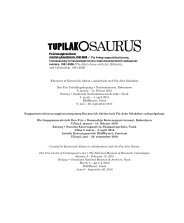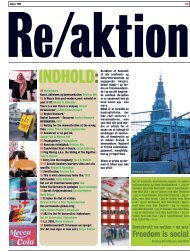tupilakosaurus - Print matters!
tupilakosaurus - Print matters!
tupilakosaurus - Print matters!
You also want an ePaper? Increase the reach of your titles
YUMPU automatically turns print PDFs into web optimized ePapers that Google loves.
1981-2006<br />
limanngitsunik isiginninneri takussutissiaralugu<br />
inuttalersorsimagamiuk. Suliami<br />
tassani Arkep isiginnittup isigisallu paarlanneqarneri<br />
takutiutigalugu, eqqumiitsulianik<br />
tuniniaaviit paatsiveerutsippai:<br />
Inuit, eqqumiitsulianik pisinermikkut<br />
kalaallit assilialiaannik “piginnittunngortut”,<br />
takussaasumik assilineqarnerisigut<br />
isiginnaagassiarinerisigut allaallumi inunnit<br />
allanit pigineqalersinnaalersillugit.<br />
Arke 1992-mi Dansk Polar Centeri Strandgade<br />
100-miittup kusassarneqarnissaannut<br />
piumaffigineqarsimavoq, tamannalu<br />
allaanerusumik suleriaaseqarluni iliuuseqarfigaa.<br />
Atortussani amerlisarniarlugit<br />
Danmarkip Katersugaasivissuani Kalaallit<br />
Nunaat pillugu ataavartumik saqqummersitat<br />
(Nationalmuseets permanente<br />
Grønlandsudstilling) pulaarsimavaa,<br />
katersugaataanilu atortut arlallit assilillugit<br />
qalipassimallugit. Qalipakkat<br />
taakku tassa assileqqissaarlugit suliarisimavai,<br />
natures mortes, taakkulu Arkep<br />
piareersarluni assitalersuinerminut<br />
suliarisimasaatut takuneqarsinnaallutik<br />
atsersimallugillu Nature Morte allatulluunniit<br />
Perlustrationer 1-10 (1994). Assilisatullu<br />
taakku piareersaataasimasut<br />
inuiaat pillugit katersat nittarsakkani<br />
assilineqartarnerisut saqqummersitsivinniittarnerisutullu<br />
takutippai. Taakkunani<br />
aamma siunertaavoq takorluueriaatsip<br />
isaterneqarnissaa. Assilisap isikkuata<br />
qalipaganngortinneqarnerinilu avissaanganerujussuaq<br />
pilersissimavaa, ilaarlugu<br />
assilisap sinaakkuserneqarneratalu akornanni.<br />
Sakkortuunik qalipaasersorneqarnerisigut<br />
aappaalaartoq kadmium,<br />
kajortoq ikumasimasoq, tungujortoq<br />
kobolt qalipaasiullugit atortut kinaassusitoqaat<br />
ersernerluttunngortippai, taamaalilluni<br />
inuiaat pillugit parnaarussatut<br />
katersaaneriniit aniguisillugit nutaanik<br />
oqariartuuteqarnissamik nukissalerlugit<br />
eqqarsaatigisimanngisaagaluatsinnillu<br />
takorluuisinnaanerput annertusarlugu.<br />
Misissorniakki pillugu Arke ima oqaasertaliisimavoq.<br />
Kalaallit nunataata qalipaganngortinnerani<br />
ilisarnaasersuisarneq<br />
kalaallillu pisataasa katersugaasivimiittut<br />
assileqqissaarneri pineqarunarput:<br />
“Inip pisataasa suunerinik nalornginarsisup<br />
isikkua qanoq ittuua? Ilisarisaqarsinnaaneq<br />
soqutaajunnaarsimappat assillu<br />
isigisat allamut alakkaatsimmatigut?”<br />
Stefan Jonsson<br />
Pia Arke. Paintings. 1981-2006<br />
Alongside her photographic works<br />
Pia Arke experimented from the<br />
beginning of her career with the<br />
classical branch of the visual arts:<br />
oil painting. Here she typically<br />
chose the most traditional genres:<br />
landscape, portraiture and still life<br />
or nature morte. The private and<br />
public commissions she received<br />
gave her opportunities for testing<br />
out the conventions that have dictated<br />
how Greenland and Greenlanders<br />
have been turned into<br />
pictures and spectacles for Danish<br />
and Western eyes. The tone is<br />
often humoristic, the undertone<br />
melancholic and political.<br />
A typical Greenland picture uses a<br />
limited number of props. They are<br />
obligatory: “Eskimo” (alone or in<br />
a group), kayak, polar bear, seal,<br />
fish (or some other Arctic animal)<br />
and a snowscape. In the paintings<br />
from the mid-1980s we see how<br />
Arke intentionally submitted to<br />
this limitation. Her motifs are also<br />
Eskimo, kayak and seal. But she<br />
stylises the motifs, renders them<br />
abstract to a point where the landscape<br />
is emptied of reality. It is<br />
deprived of its naturalistic illusion<br />
and transformed into what it has<br />
always been – an exoticised and<br />
primitivistic emblem for the alien.<br />
Arke submits to this convention<br />
in order to turn it inside out. She<br />
wants to show the viewer what<br />
Greenland is expected to look like<br />
in a picture. But she also wants to<br />
show what paintings a Greenlandic<br />
artist is expected to paint.<br />
Arke played with and made<br />
fun of these expectations in a<br />
way that can make the viewer<br />
laugh – for instance in front of a<br />
painting from 1987 titled Camel<br />
in Snowscape. But perhaps even<br />
more clearly in the project that<br />
was running in parallel with her<br />
paintings, in which she parasitised<br />
on her public by photographically<br />
documenting the people who<br />
bought her paintings, whereby<br />
they came to personify the<br />
metropole’s view of the periphery.<br />
In this project Arke reverses the<br />
relation between the viewer and<br />
the viewed while at the same time<br />
short-circuiting the art market:<br />
The people who through their art<br />
purchases become “owners” of a<br />
Greenlandic painting are exposed<br />
as objects in a photo that for its<br />
part can be viewed or even owned<br />
by someone else.<br />
In 1992 Arke was invited to<br />
decorate the Danish Polar Center<br />
at 100 Strandgade in Copenhagen,<br />
and this time set about things<br />
rather differently. She expanded<br />
the number of her props by<br />
visiting the National Museum of<br />
Denmark’s permanent Greenland<br />
Exhibition and choosing a number<br />
of objects from the museum’s collections,<br />
which she then painted.<br />
These paintings, then, are literally<br />
still lifes, nature mortes, and can<br />
be seen today as preliminary studies<br />
for Arke’s photographical suite<br />
Nature Morte alias Perlustrations<br />
1-10 (1994). As in the photographs<br />
in the suite, she here depicts the<br />
ethnographical objects in accordance<br />
with the same perspective<br />
from which they are depicted in<br />
ethnographical catalogues or museum<br />
showcases. But here too the<br />
intention is to destroy the illusion.<br />
The paintings contain a colossal<br />
tension between their motifs and<br />
their execution, between subject<br />
and framing. Through a strong<br />
colour scheme of cadmium red,<br />
burnt umber and cobalt blue Arke<br />
erases the old identities of the<br />
objects, liberates them from their<br />
ethnographical prison and gives<br />
them strength to disseminate new<br />
messages and to activate unknown<br />
fantasies.<br />
Arke formulated the question<br />
she wanted to investigate in a<br />
commentary. It probably has to do<br />
with both her stylised Greenland<br />
landscapes and her still lifes of<br />
Greenlandic museal objects: “What<br />
does the space look like where one<br />
ceases to know what things are?<br />
Where recognisability becomes<br />
unimportant because the picture<br />
opens up for something else?”<br />
Stefan Jonsson<br />
33




